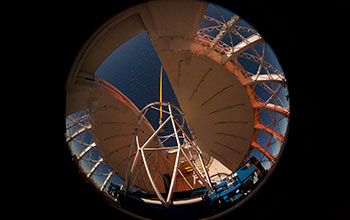Multimedia Gallery
Gemini North with Laser Guide Star
A 180-degree fisheye view of the Gemini North Telescope on Mauna Kea, Hawaii, as it is lit by moonlight and the red glow of a passing automobile's taillights shining through the wind-vent gates. At the top of the seven-story-high telescope structure, the laser guide star (LGS) can be seen extending into the sky where it creates an artificial star used by an adaptive optics system, to correct for distortions caused by turbulence in the Earth's atmosphere.
The Gemini Observatory consists of twin, eight-meter optical/infrared telescopes located on two of the best sites on our planet for observing the universe. Together, these telescopes can access the entire sky.
The Gemini South Telescope is located at almost 9,000 feet on a mountain in the Chilean Andes called Cerro Pachon. The Frederick C. Gillett Gemini North Telescope is located on Hawaii's Mauna Kea. It is part of the international community of observatories that have been built to take advantage of the superb atmospheric conditions on this long dormant volcano that rises almost 14,000 feet into the dry, stable air of the Pacific.
Gemini was built and is operated by a partnership of seven countries, including the U.S., United Kingdom, Canada, Chile, Australia, Brazil and Argentina. Any astronomer in each partner country can apply for time on Gemini, which is allocated in accordance with the amount of financial support provided by each country. To learn more about Gemini, visit the observatory's website Here. (Date of Image: June 2007)
Credit: Gemini Observatory
See other images like this on your iPhone or iPad download NSF Science Zone on the Apple App Store.
Images and other media in the National Science Foundation Multimedia Gallery are available for use in print and electronic material by NSF employees, members of the media, university staff, teachers and the general public. All media in the gallery are intended for personal, educational and nonprofit/non-commercial use only.
Images credited to the National Science Foundation, a federal agency, are in the public domain. The images were created by employees of the United States Government as part of their official duties or prepared by contractors as "works for hire" for NSF. You may freely use NSF-credited images and, at your discretion, credit NSF with a "Courtesy: National Science Foundation" notation.
Additional information about general usage can be found in Conditions.
Also Available:
Download the high-resolution TIF version of the image. (5.4 MB)
Use your mouse to right-click (Mac users may need to Ctrl-click) the link above and choose the option that will save the file or target to your computer.

